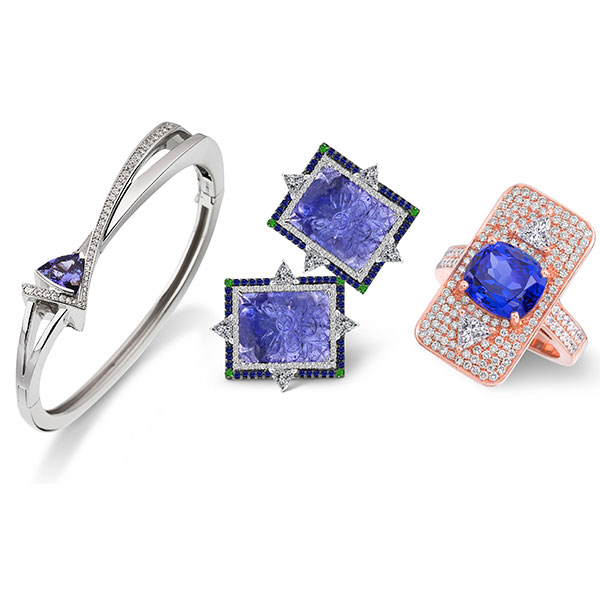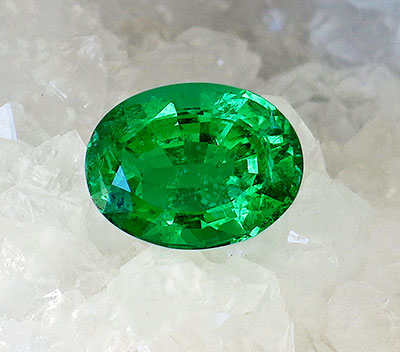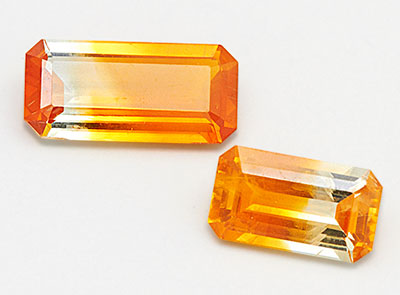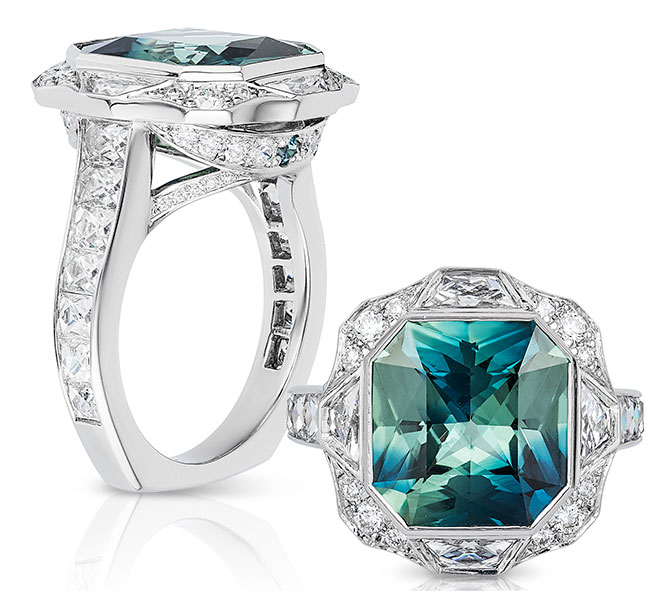
Add tanzanite, Ethiopian emeralds, and bicolor sapphires to your gem week shopping list
Purple Reign
Since it was discovered in 1968 in the Merelani region of Tanzania, in the foothills of Mount Kilimanjaro, tanzanite has been something of a shape-shifter in the marketplace.
Introduced to the world by Tiffany & Co., which christened the stone, the gem was initially touted for its rarity and sought after by the finest designers of the time, including Jean Schlumberger and Donald Claflin.
By the late 1980s and ’90s, however, tanzanite had acquired a reputation as a mass-market gem, thanks in large part to the cruise ship industry, which made styles like tanzanite tennis bracelets a staple of the vacationer’s wardrobe.
Today, jewelers remain besotted with tanzanite’s range of colors, from intensely hued purple-violet to a pastel-like lavender. And from the most recent Couture Week in Paris to the aisles of JCK Las Vegas, the stone is once again a designer darling.
Denver-based John Atencio has used the gem since the late 1980s. He attributes his unwavering commitment to the stone, which he prefers to use in deeply saturated trillions, to “the passion and beauty of the color, the price point, and the scarcity of high-quality tanzanite in the market.”
For Lauren Kessler, founder of New York City–based Lauren K Fine Jewelry, tanzanite’s “luxurious and bold” color is why she’s given the gem a permanent place in her collection. “I use it in many variations: gemstones, rose cuts, and beads,” Kessler says. “I like the stone in yellow gold and rose gold. I’ve purchased unheated, lighter-colored gemstones and fine, deeper-, richer-hued stones as well.”
Stuart Robertson, JCK contributor and vice president of Gemworld International in Glenview, Ill., says a major reason tanzanite is finding favor among designers, yet has become less sought after by the industry’s mass marketers, is a complicated supply-side dynamic that stems from the Tanzanian government’s recent efforts to clamp down on production in order to prevent smuggling across the border into Kenya.
“They’ve stopped issuing new miner’s permits and broker’s licenses,” he says. “They see it as their national resource and want to see more benefit for their population. So it’s created a real problem.
“A decade and a half ago, you used to see lots of manufacturing in tanzanite, but large companies aren’t willing to make huge investments in a stone that has that much instability,” Robertson continues. “And tanzanite has seen a very sporadic price structure in recent years. Right now, you can buy relatively nice stones for a lot less than a decade ago. At wholesale, really nice material goes from $350 to $425 a carat for 5- to 8-carat stones.”
For a single-source gem that represents arguably the most important color find of the 20th century, that can mean only one thing: You snooze, you lose. —Victoria Gomelsky
Emerald City

If the 2018 Tucson gem shows were a Hollywood production, the star would surely have been the Ethiopian emerald, the breakout gem of the season.
Discovered in 2016, in a deposit in the country’s south-central region about 12 miles south of a town called Shakiso, the emeralds have been praised for their bright-green hue. “They often have a bit less color saturation than the Zambian emeralds, which is not a bad thing because very often the Zambians are oversaturated,” says dealer Roland Schluessel, co-owner of Pillar & Stone in San Francisco. “And when you have a little less color, you have a lot of sparkle. The brilliancy of these emeralds is unusually high.”
Opinions differ on how closely the Ethiopians resemble Colombian goods, the standard-bearers in the emerald market. Schluessel, however, is unequivocal: “The look is different,” he says. “The fluorescence in Colombian emerald supercharges its color and adds to its brilliancy. Additionally, Colombian emeralds are found in large sizes; you can have 600-carat stones. But what was missing from the market was this bright material that is not Colombian, with a significantly lower price that can open a new market—and that’s where Ethiopian comes in. It’s half the price of a comparable Colombian emerald. It wholesales between $500 and $10,000 per carat in sizes up to 10 carats. But we also have a 30-carat.”

Beyond their bright good looks, Ethiopian gems boast another appealing quality. “Over half of the emeralds do not need oil,” Schluessel says.
After Ethiopian emeralds’ coming-out party in Tucson, the attendant buzz jump-started prices in time for JCK Las Vegas. “In Tucson, they seemed to be trading 10 to 15 percent below Zambian material, but when we saw them in Vegas, they had reached the level of Zambian with some stones going higher,” says Gemworld International’s Stuart Robertson.
The hoopla over the East African goods reflects the hype surrounding the emerald market in general, according to Robertson. “When gem prices ran up at the beginning of this decade, ruby and sapphire prices went up insanely; emerald did not,” he says. “There’s still a lot of room for emerald prices to climb before the market gets cautious. We see emerald emerging as a very strong seller in 2019.” —VG
Bicolor Curious?

According to a number of sources—and our own observations—the popularity of bicolor sapphires is on the rise among studio designers and small, gallery-format stores that cater to millennials.
Eric Braunwart, owner of Columbia Gem House in Vancouver, Wash., a top supplier of bicolor (also known as parti) sapphires, confirms that over the past three years, he and his team have been intentionally cutting the gem to enhance, or call attention to, its inherent bicolor banding or zoning effect.
The timing aligns with what designer Jenifer Thai of IO Collective in Los Angeles recalls about her work with the stone. “I first saw a bicolor sapphire in Tucson four years ago, but I actually didn’t work with it until last year,” she says.
Braunwart says his company’s current, and growing, bicolor sapphire inventory—mainly specimens from Malawi and Montana—is “a response to a market that came to us. We’re cutting bicolor sapphire from lots of locations, and do some heat treatment to accentuate, not mask, the weaker color.”
The mainstream jewelry industry still largely favors traditional blue sapphires, the majority of which have been heat-treated to make the color appear more uniform and evenly distributed. But Braunwart says the millennial market tends to recast “flaws” as desirable traits, requesting stones that have been cut to highlight, not disguise, inclusions and other natural nuances. Designers find this kind of material appealing because it offers a way to fulfill demands for one-of-a-kind jewelry styles that feel authentic, not cookie-cutter.

And bicolor sapphire is uniquely appealing because it’s more unusual than, say, ametrine or even bicolor tourmaline. Designer Meredith Young is drawn to the blending of “nature’s watercolors, whereby one color bleeds into the other,” she says. “I just bought a pair of geo-cut bicolor Montana sapphires that are small, but with this type of soft, romantic ombré coloration, size doesn’t matter.”
Larger bicolor sapphires are rare and difficult to source. At the most recent American Gem Trade Association Spectrum Awards press preview, attendees were gobsmacked by a 6.78 ct. blue-green beauty—unheated and untreated—from Madagascar in a platinum ring by Southern California–based Lindsay Jane Designs that won a Women’s Jewelry Association Gem Diva Award and Classical-Manufacturing Honors.
If untreated material is your top priority, African and Australian bicolor sapphires require little “assistance” beyond a spectacular cut, dealers say. Also look for lavender-pink bicolor sapphires from Vietnam. “When you add heat to lavender it usually goes blue or pink,” Braunwart says. “So a stone that retains that lavender color is very uncommon.” —Amy Elliott
Top: Pinnacle bracelet with 9 mm tanzanite and 0.44 ct. t.w. diamonds in 14k white gold, $7,250, John Atencio, 720-445-5292, johnatencio.com; earrings with floral carved tanzanite, diamonds, sapphires, and tsavorite in 18k white and blackened gold, $10,350, Vivaan, 212-302-0402, vivaan.us; Aria ring in 18k rose gold with 5.35 ct. tanzanite and diamonds, $21,500, Lauren K, info@laurenk.com, laurenk.com